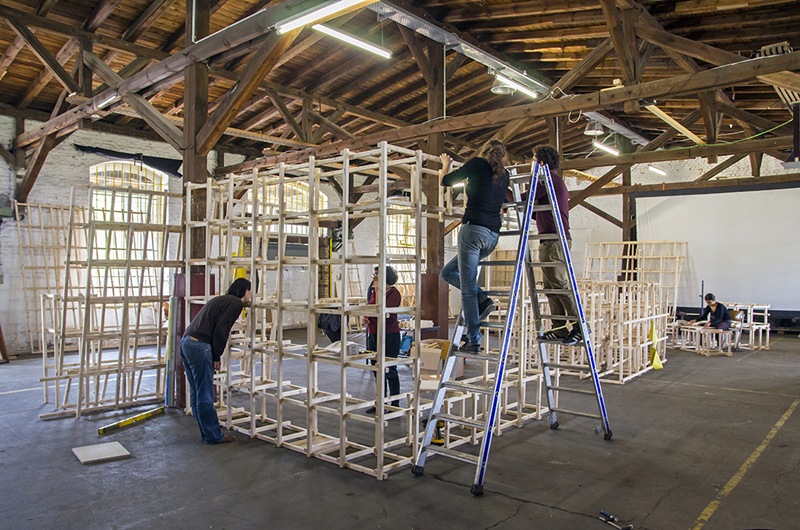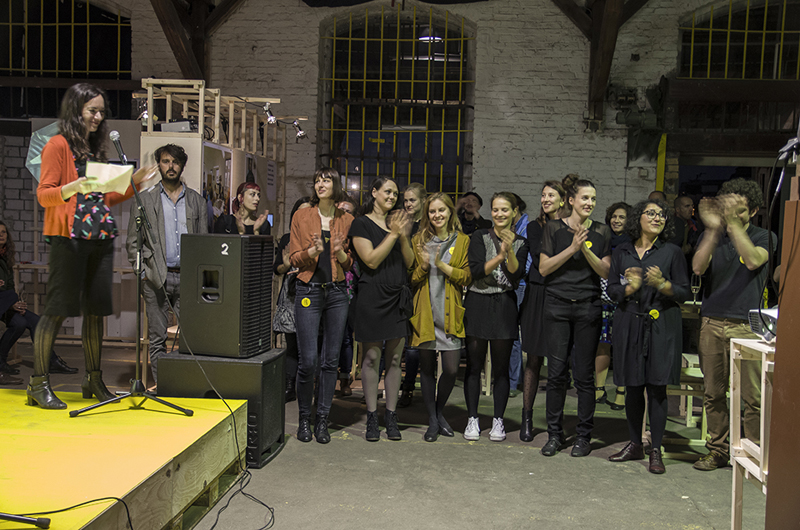
Womannschaft
Joanne Pouzenc
Feminine thinking A couple of weeks ago, I received an impromptu invitation to a fabulous dinner. Based on an original idea from Niche Berlin with Rosario Talevi and supported by Perspektive – a programme of the Institut Français in Berlin – the hosts gathered around the table some 20 special guests to think about the […]
Feminine thinking
A couple of weeks ago, I received an impromptu invitation to a fabulous dinner. Based on an original idea from Niche Berlin with Rosario Talevi and supported by Perspektive – a programme of the Institut Français in Berlin – the hosts gathered around the table some 20 special guests to think about the production of space from a feminine point of view. The guests were all space related, mainly architects and apart from two witnesses coming from the male‘s league, they were all women. But whereas architecture was our common point, almost none of us was still a practitioner: all of our career paths brought us to wider our horizon and to diversify our practices to the cultural, artistic, curatorial or teaching field.
Why that? Have we made a step forward on our individual pathways or have we intended to flee from our architectural fate?
Before that occasion presented, I didn‘t really embarrass myself with feministic thoughts. My experiences taught me not to dissociate males from females and certainly not to claim any difference. I always accepted as law that women who decide to make a man‘s job should be aware that the same qualities would be expected from her. Whereas around the table, some very strong characters preferred to defend the idea that women need to fight to get their own way in a man‘s world, I‘d rather defend that women need to adapt and that the dichotomy between men and women should be just ignored. But that dinner blew my mind: of course this distinction exists and is extremely present. Furthermore, to what exactly should women adapt? Very often if not daily, women suffer from machist untold rules in their work environment. And if those rules don‘t apply, for cultural or societal reasons, it‘s sometimes the woman alone who is forcing herself in being as efficient and as productive in every field in which men excel, if not better.
A woman style
The first time I visited a building site, I was still a student. In the frame of an „on the ground“ training, I had picked a woman architect to follow one of her project in the process of being built. The project was relatively small – a couple of houses in an urban environment – but already very impressive for the future architect-to-be that I was back then. Actually, any project was truly impressive: as a student, I was constantly asking myself how is the shift operated between the drawing on the paper and the built reality. I was frightened by the amount of information I would still need to get to be an architect – hopefully, a good one.
As I was waiting for that lady architect to come, I was surprised to see her coming with her „lady“ style: heels she could exchange for the non-secured yet „at least closed“ ballerinas she had in her bag, a normal-formal skirt and jacket, and her dog on a leash. It seemed pretty relaxed. After five minutes of courteous hand shakes and smiles, she asked one of the worker to hold the dog for her whereas meanwhile she would climb a ladder and go check the first floor with another guy. I didn‘t think this was truly efficient but I felt relieved. Efficiency might not always be the only measurement tool. As anything else, measured „efficiency“ as a productive factor should also be considered on short terms and long terms perspective. What I observed back then was maybe the insurance that the relation Architect/Worker did in fact work quite well. It helped me understand there was a possibility to express and assume femininity anywhere, and also – of course – within an architectural practice.

Berlin Unlimited

Berlin Unlimited
21st Century and popular beliefs
When I finally graduated, I was very proud to bring my architect title onto conversation. At least the first few times. There is always a moment when people are asking you „What are you doing for a living?“ and this question often comes right after the „What‘s your name/ Where do you come from“ one – in the first five minutes. Depending on the milieu or location I was when asked this question, I had often – very often! – to face a strange reaction after I proudly brought the „I‘m an architect“ answer. Immediately, as a reflex, people would answer: „You mean Interior Designer?“ = choosing the carpets, the colors of the pillows, the fabric of the curtains and the pictures to be framed on the wall. The worse though would come from the fact that women as well had that question-reaction. I apparently didn‘t fit with their image of „The architect“ and if falling in such clichés is a widespread practice, let me risk myself in bringing some more stereotypes.
Different technics, same results
Men to men relations when becoming conflictual or having to defend opposite interests are often based on force, strength or pressure. Threats, anger or loud voices are current issues on construction site. I‘m not saying that construction sites are necessarily a matter of conflicts and I have also seen some smooth ones going on… but conflicts appear and men and women seem to have a very different approaches to it. Of course, the architect has always the same threatening tool that doesn‘t depend on gender: money. But the way deals or negotiations are made differs definitely from one gender to the other. I‘ve seen working men on construction site spending the first minutes testing out the competences of the woman architect. By arriving, the woman architect will be asked a series of tricky technical questions for which maybe even the man architect wouldn‘t have any answer. Her competences would be then stated in front of the group according to the answer she would give.
I wondered for a long time what the good answers were: I have tried several techniques before finding the best fitting one, the one that would give me the green light to lead the construction site and gain the initial respect from the group of people with who I would be working in the next months. I‘ve faked a «good» answer that appeared to be the wrong one, I‘ve tried to change the topic by pointing out another more urgent emergency, I‘ve initiated some sexists jokes or jumped on the occasion to laugh at some, I‘ve tried the „I don‘t know – I‘ll ask my boss and give you an answer (once he has enlightened my dark ignorance)“, I‘ve made it evolve into „I don‘t know – I‘ll make some researches and I‘ll give you an answer“ and that was the closest possible answer to gaining respect I could find. Until I just decided to be honest and stop caring: there are things I know, some I don‘t, some I‘m good at, some I suck at. And it can be gender related – or not at all.
As well within the construction process, I‘ve experienced that gentleness, politesse and understanding can also be used to obtain good results. Moreover, when those protocols are combined with an already acquired respect, the global mood along the construction goes smoother and all the team works together to match a common interest: making it happen and making it good.
Building content
With more experience, the process of being respected gets maybe faster, but undoubtedly, one has to go through the exact same power testing in the beginning. But in the cultural-architectural sector, feminine presence seems to be much more accepted. Furthermore, in Berlin, women seem to have the leadership of architectural content: the cultural teams of architectural curatorial practices are often built under the lead of strong connected women who are entitled to bring back on the paper – and on exhibition spaces – what one has been building and concreting somewhere else.
I‘ve been working in the last year with and within women team: not that femininity was a requirement for getting the job: it was simply a coincidence of fitting curriculum vitae cumulated with the wish to bring to their architectural practices some meaning. At first being a bit worried, aware of the hard competition level that women operate between same gender individuals, I quickly observed how women communities can work efficiently together, whatever tasks would be given.
As such, within Berlin Unlimited (which counted only two late coming men within a team of 15), women have designed, organized, estimated, negotiated and built up the entire structure – literally and metaphorically – for a seven days long festival about Arts, Architecture and Urban Research. Whereas I was stuck on office duties, my collaborators sent me a video of the construction site. The short video featured a couple of beautiful women mastering the art of loud power drills and screwdrivers, singing some famous jazzy balades over the music in the background, covering the noise of their tools while assembling the structures. I wondered quite a lot why no men had joined this adventure. Perhaps men were just more pragmatic and not willing to give their competences for free to a cultural cause. But the more I receive new applications for future projects, the more I have to face it: they keep coming mainly from the feminine sphere. Women might just need «more» to fulfill their satisfaction ratio. More challenges, more overviews, more domains of expertise, more diversity, more contacts, more adaptability… Unless, once again it‘s purely coincidental. Surely, the place I chose for a living might influence and/or enhance these tendencies: in France, I‘ve had more balanced experiences, in New York, I was the only girl in a 90% gay firm (who actually interpreted from the lack of picture on my resume that I was a boy – funnily and naturally), in the Bauhaus in Dessau, we were 20 ladies out of a research team of 24. I deliberately chose to exclude from my considerations the parts of the world where the differences Men/Women are in fact the most pregnant: I just have absolutely no clue about those parallel realities and I unlikely would be the right speaker to depict them. But before calling it a «women phenomenon», I will just keep my eyes and feminine high sensitive receptors wide open: maybe there are in those differences a lot to learn from to finally reach a real balance.
Joanne Pouzenc (joannepouzenc.com) is a French architect, curator, professor and urban researcher based in Berlin. After eight years of architectural practice between France, Germany and New York, she initiated a curatorial career within the Bauhaus Dessau Foundation program in 2010 that led to Europe-wide exhibitions (Bauhaus Dessau Foundation, S AM Basel, House of Arts – Brno). She co-founded CollageLab withPhiline Schneider in 2012 and in 2014, she coordinated and curated Berlin Unlimited (berlinunlimited.org), the first international festival for Arts, Architecture and Urban Research in Berlin. In 2015 she joins the Make City (makecity.berlin) festival in Berlin as associate curator and late executive producer. She is currently teaching at NODE (nodecenter.net), Center for Curatorial Studies in Berlin and as associate professor at the Architecture School of Toulouse.